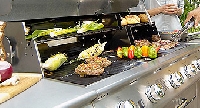
It’s easy to learn to grill – don’t be a burnt hotdog!
Most guys believe that they were born knowing how to grill. As anyone who has attended a cookout can tell you (including my early ones), that?s simply not true.
Even if you have a DNA test that proves you descended from the guy who invented fire and flame-broiled pterodactyl wings, you can still improve your techniques by joining the rest of us and take a few minutes to learn to grill.
It’s called grilling because your main tool is a grill, so it’s a good idea to get to know yours. Practice doesn’t make perfect but it will keep you from making burnt steaks. Grills are not created equally, so it pays to do some pre-cookout experimenting with hamburgers, hot dogs or even slices of bread. Covering the grate with bread and toasting it will identify hot and cold spots.
Even if your grill has a built-in one, invest in a good grill thermometer that you can move around to get accurate temperatures. If you’re using a charcoal grill, use fresh coals whenever possible and keep leftover coals in a dry place. Practice adjusting the vents to regulate the temperature. When using a gas grill, always preheat for at least 15 minutes and use the thermometer to accurately determine what temperatures are high, medium and low.
~
Technique
Once you feel comfortable with regulating your grill’s temperature, it’s time to learn technique. The sign that a food has been cooked on a grill is grill marks. Get them early by starting out with the grill at a high temperature to make the marks and sear in the juices. This only takes a minute or two so be prepared to act fast.
Oil the grates before putting the food down to prevent sticking and have an area set aside at a lower temperature to move the food to when it’s marked – this is also the place to move it to when there’s a flare-up. By moving the food away from the flames, you prevent burning and allow the flames to die down on their own without water. Once the food is seared, the real cooking begins.
Use recipes and grill instructions as guidelines to go with what you’ve learned practicing. Most foods cook better when grilled slowly over low heat or even indirect heat – that’s where you move the food to an area where there’s no flame under the grate and use the heat of the other burners or coals to cook it.
Be patient ? good grilling takes time and much of it with the lid closed. Resist the urge to poke and flip, but when you do, do it with quality utensils designed for outdoor grilling. While looks are important, let temperature be your gauge for doneness by using a good quality instant thermometer.
Flavoring
When it comes to marinades, rubs and sauces, follow their instructions with these extra guidelines. Marinades and rubs need time to soak into the food so apply them early and never using them once the food is on the grill. On the other hand, most sauces are best applied shortly before the food is done to prevent burning.
Clean up
Once you’re enjoyed your food, take a few minutes to clean your grill with a proper cleaning brush and remove ashes, charcoal and wood. Learn how to treat your grill like the precision cooking tool that it is and your next cookout will be safe, successful and tasty.

